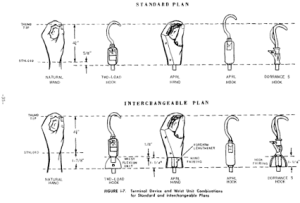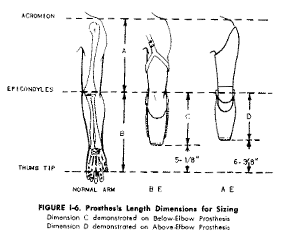4b. Length and Alignment
Length and alignment of the forearm and the wrist unit affects the ease and efficiency of the movement. Align the prosthesis for optimal ergonomics.
Process to Determine Length
Length of forearm may be determined based on contralateral limb length, functional length, or using the Carlyle index.
- Typically match R and L arm lengths: measure lateral epicondyle to thumb tip with elbow at 90`.
- Functional length – this may be shorter than the patient’s contralateral limb or shorter than the result from the Carlyle index.
- The Carlyle index is the ratio of the limb length to height (This works for both women and men)
- Humeral length (AC to lateral epicondyle) = 0.19 times body height
- Forearm length (lateral epicondyle to thump tip) = 0.21 times body height
Length may differ if using two different TDs. See Interchangeable Plan below.
Process to Determine Appropriate Alignment
Forearm alignment is based on the residual limb length and the functional needs of the pt
- Long transradial limb
- Align the PVC tube and socket so that the tube axis is the same as the socket axis and is at right angles to the elbow axis
- Short transradial limb
- Align the tube so that the forearm is pre-flexed inside the form
- Re-check forearm length as the patient performs various tasks.
Wrist alignment options:
- Square off the wrist unit so that it is perpendicular to the forearm axis
- Cant the wrist up to 5 degrees anteromedially (typical)
- Align relative to patient specific functional needs
Interchangeable Plan for Length
…when the patient has the need for more than one TD
- Consider the length of the wrist and the TD when determining the length of the prosthesis. Note that Wrist units are generally ¾” and socket lamination takes up another ¼”.
- Remember to add length to the cable, e.g., hook to hand cable adaptor.

Notice that the standard plan allows only limited interchangeability, no wrist unit, and limited accommodation for the artificial hand. [1]

4 ½ + 5/8 = 5 1/8
- NYU Supplement page 35 ↵
the study of matching job requirements and environment to the worker to maximize efficiency, quality, and quantity of work.
